Walking round London pt25: Richmond Bridge to Isleworth
The fourth quarter of the capital circumnavigation starts with four bridges
(ICYMI: Having executed a 120km circumnavigation of the capital for charity, the writer has produced these blogs to publicise the fundraising and consider the vernacular. There’s a full list of chapter/sections at the end of each blog.)
In his charming if verbose treatise A Philosophy of Walking, Frédéric Gros insists that the best perambulations are taken in complete detachment from the outside world, a state of mind he suggests is preferable to the modern always-on obsession with the hurly-burly of distant events.
“When you walk,” he begins, “news becomes unimportant. Soon you have lost all knowledge of the world and its gymnastics, the most recent own goal, the latest scandal… Being in the presence of what absolutely endures detaches us from that ephemeral news for which we are usually agog.”
Such had been the case with me on the first three quarters of the 120km Capital Challenge. Willingly taking myself out of circulation to walk for the sake of it, not against a deadline or to-do list, and to take as long as it took — this was a literally refreshing change. It allowed me to reassess my priorities, to come to terms with changing circumstance on a much deeper and more fundamental basis than reacting to Trump’s latest tweetstorm.
But the final quarter would be different. For on Saturday 7 July, I have a self-imposed deadline: England are playing a World Cup quarter-final at 3pm, and I’m going to watch it. That means either stopping mid-walk or doing the full 30.5km in less than six hours: a 5kph pace, 25% faster than my previous rate. Still, the latter is my intention and as I’m not alone in this aim, Mencap kindly make sure there will be a TV set at the finishing line for those who wish to power through.
Those of us eyeing the clock turn up early at the Richmond Bridge start line, hoping to be away as soon as possible. Although the footpaths are public there’s a health-and-safety restriction on letting us go until the Mencap’s waymarking signs have been posted by bicycling outriders, but at 8.15am we’re allowed to set off.
And so it is that five of us cross Richmond Bridge in the morning sun, captured by the photographer in an image that Mencap will later use for the 2019 Capital Challenge homepage (do sign up). It’s going to be hot — a forecast 31C — but it’s shady and cool as we head downriver on what used to be known as the Surrey bank.
There are several river crossings at Richmond. As the eldest, the 1777 humpback bridge bagsies the town’s name. Half a kilometre down the popular towpath promenade — technically known here by the marvellously plummy names of Buccleuch Passage and Cholmondeley Walk, after a duke and earl respectively — there’s the iron railway bridge.
Something of a Trigger’s Broom, the Richmond Railway Bridge was opened in 1848, engineer Joseph Locke’s cast-iron beams connecting Reading and Windsor via Richmond with Clapham Junction and thus the newly-opened Waterloo terminus. However, the 1891 collapse of a similar bridge near Norbury Junction led to a 1908 rebuild with the existing piers and abutments connected by fresh steelwork, designed by the same bloke (JW Jacomb-Hood) who gave Waterloo its vast roof, and proudly boiler-plated for the attention of passers-by. Then in 1984 the main bridge girders and decking were replaced again.
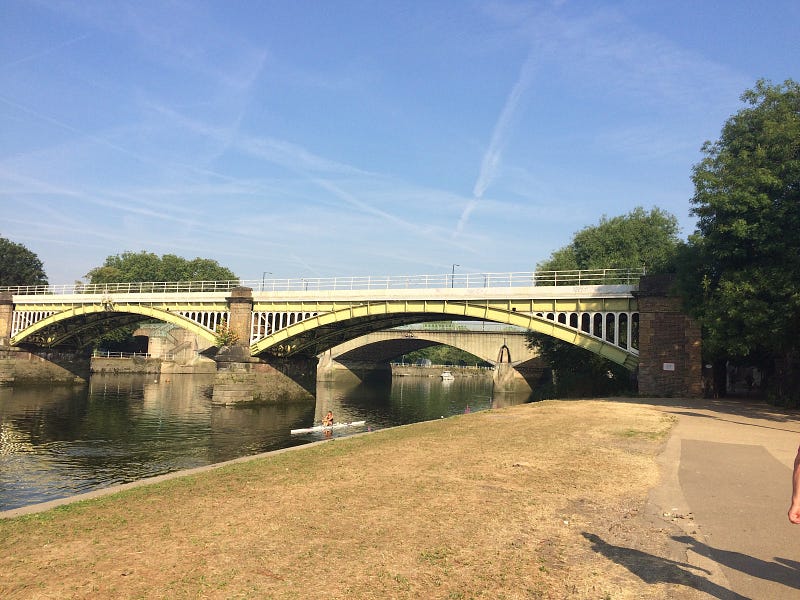
Even so, the bridge retains its 1840s aesthetic, the vertical dividers of its open spandrels chiming nicely with the similar design of the Richmond Lock, just downstream.
Splitting those siblings, however, is a design which speaks of a different era. Just as the railways had snaked outwards in the 1840s, so did the rise of the automobile 90 years later demand newer, wider roads than mere humpbacks like Richmond Bridge. Thus it was that the Chertsey Arterial Road required the 1933 construction of a new crossing: the Twickenham Bridge by Maxwell Ayrton, the chap who had co-designed the original Wembley’s Twin Towers in reinforced concrete.
Prioritising destination over journey, the original design included four 70ft towers and retaining walls 20ft above road level. Daily Telegraph-fanned local uproar saw that off, and the resultant compromise attractively evokes an era of promise: the Art Deco embellishments are subtle, the bronzework balustrades and lamps stylish. It was grade II*-listed in 2008, 16 years after it was installed with Britain’s first Gatso speed camera.
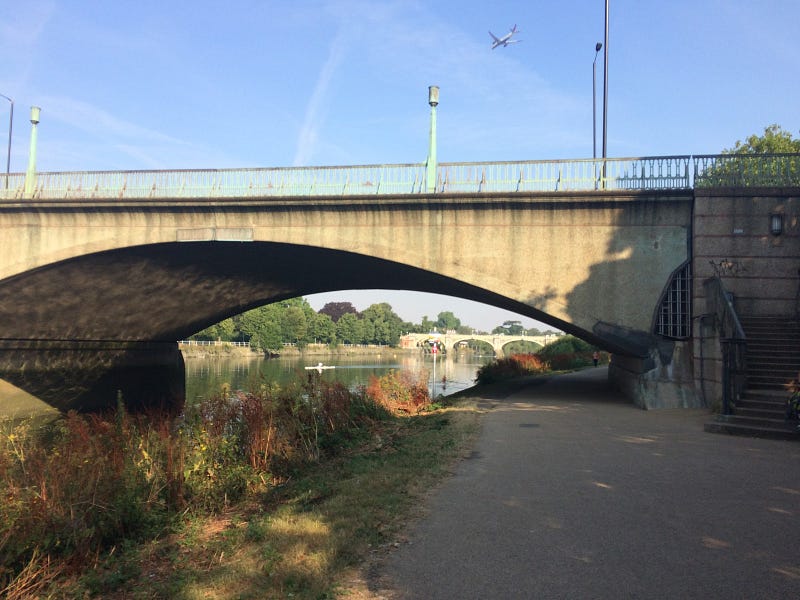
Once under the road bridge, the towpath feels clear of the town and back into the country, helped by the adjacent wide expanse of Old Deer Park. A diagonal line denotes the 1769 transit of Venus across the sun, an event witnessed by King George III — then safely sane, an excitingly young 31 years old, London-born and (unlike his Hanoverian predecessors) an English-speaker by preference.
Pleasingly scientific of mind, George wanted an observatory built to better capture the rare Venusian transit, allowing astronomers to accurately calculate the size of the solar system and educatedly estimate the distance between the Earth and sun. It was for the same reason that Captain Cook was sent to the South Seas, an adventure which ended with the crown’s ‘acquisition’ of Australia and New Zealand; the imperialist monarch would be seen in the United States as such a tyrant that the locals sought independence.
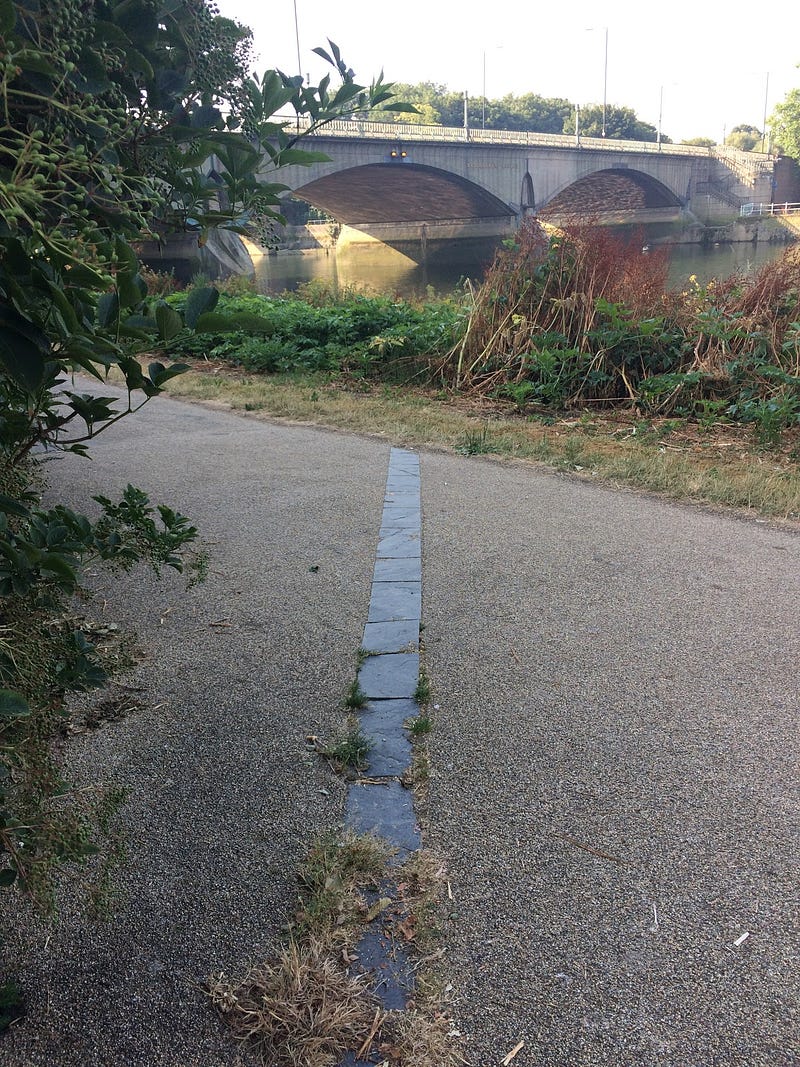
We have our own transit to effect, the rather simpler crossing of the river by the Richmond Lock. To the traffic zooming over Twickenham Bridge this may resemble another small road bridge, but it’s a low-tide barrage, the furthest downstream of the Thames’ 45 locks. It was built between 1891 and 1894 in order to keep this stretch of the river reliably navigable: tidal depths had become unworkably variable through a combination of the 1831 removal of the dam-like mediaeval London Bridge, the 1810 construction of Teddington Lock, the downstream dredging of the lower Thames and the upstream extraction by four of the city’s five main waterworks.

Until the Second World War, pedestrians were charged a penny, while sightseers who exited on the same side would be charged tuppence; the toll booths survive to this day. Like the train crossing, this is effectively two parallel bridges; here, they stand either side of the sluice gates which still rise and fall every day, usually staying up for the two hours around each high tide and down for the rest of the day — unless there is excess runoff to drain, as in the great floods of early 2014.
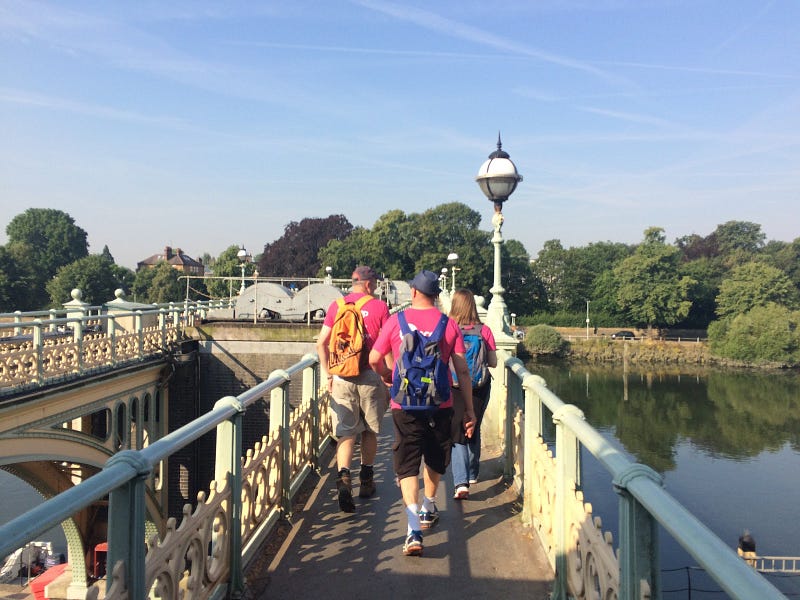
Notwithstanding the two crossings of the humpbacked Richmond Bridge necessitated by the start of this Capital Challenge leg and the end of the previous one, this is the only time the Capital Ring proper crosses over the Thames: the other crossing is through the Woolwich Foot Tunnel.
We’re now into what was once Middlesex, and it still feels as bucolic as the other bank, largely because it’s one of the most overgrown stretches of London riverside I’ve ever seen. Four-foot thistles and five-foot stinging nettles abound, astoundingly given the price of riverside real estate in these parts.
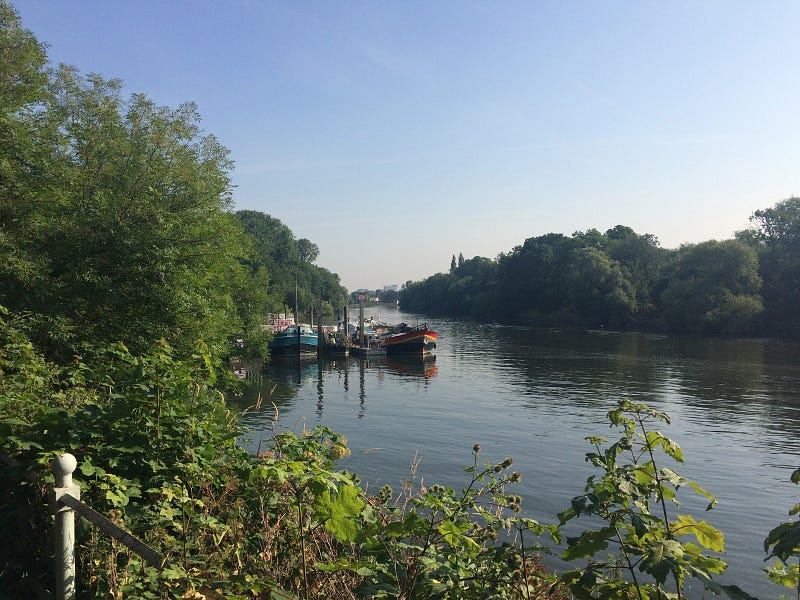
Indeed, this place seems to be called Thistleworth Marine Property — a joke on nearby Isleworth, or the plantlife, or both? Etymological investigation reveals that the first recorded example of the placename — in 695 — is Gislheresuuyrth, ‘Enclosure belong to [a bloke called] Gislhere’; but while ‘Istelworth’ (recorded 1301) became the default name, the ‘Thistleworth’ variant stubbornly crops up every now and again through history. Evidently the name is as determined as the plant muscularly described by Ted Hughes: “Every one a revengeful burst / Of resurrection … Their sons appear / Stiff with weapons, fighting back over the same ground.”
The path bobs to and from the riverside through Old Isleworth town, in among the various layers of architectural archaeology and newbuilds, some of which allow you to stroll the bank, others guarding it jealously for their private denizens.
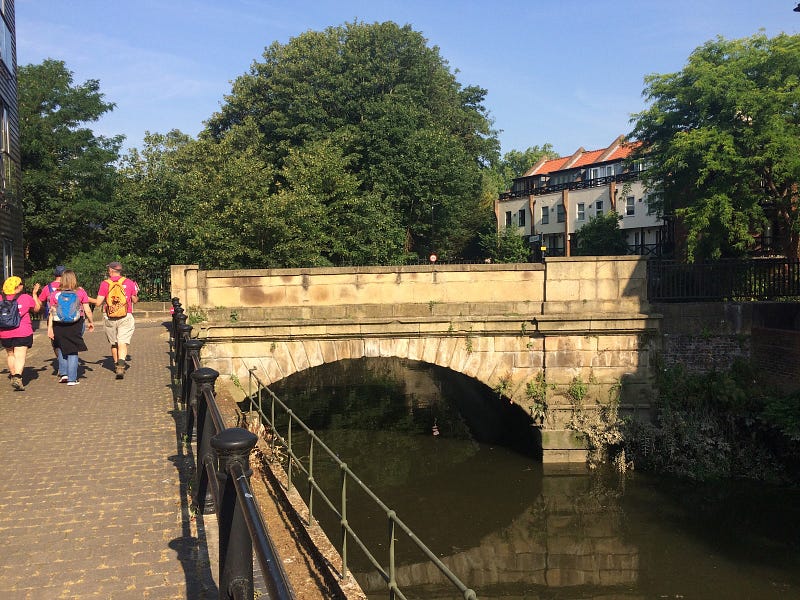
Bridge over the Crane.
Forced away from the Thames by the bulk of the former Nazareth House convent and girls’ school — now a private development, natch — the path skirts the River Crane up Railshead Road, named after the stakes hammered into the Thames to build Isleworth Weir, the better to catch lamprey, in the early 1400s. Further on, the neoclassical sandstone Mill Bridge was built in 1820 to span the Duke of Northumberland’s artificial river.
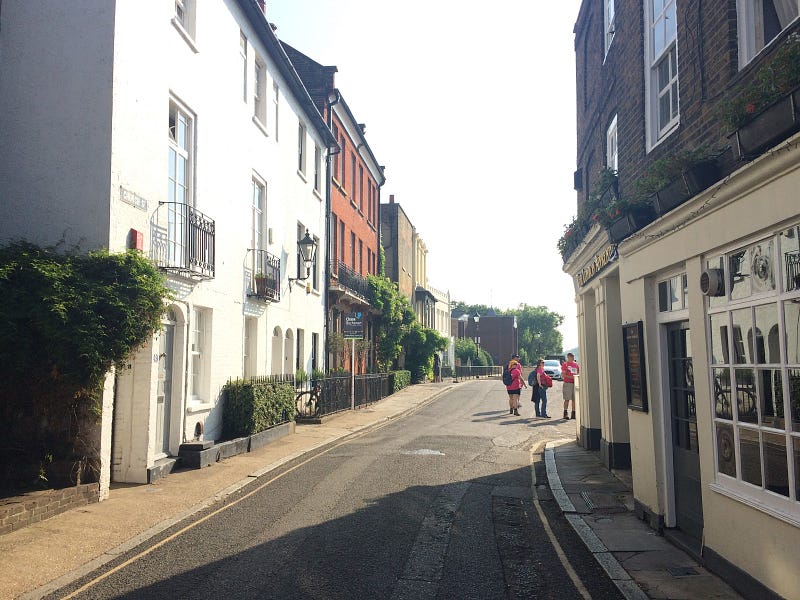
After a tiptoe down Old Isleworth’s time-capsule Church Street (and the London Apprentice pub) there’s one last hurrah for the Thames with the Ring’s final vista of London’s timeless river. And as you behold that view, behind you is a typically fascinating slice of London’s layered history.
All Saints Isleworth’s 14th-century Kentish ragstone tower is somewhat surprisingly augmented by a 20th-century newbuild. There had been a church here for centuries but by 1700 it no longer sufficed for the burgeoning Isleworth. No less an architect than Sir Christopher Wren was summoned to design a new church but his plans were too costly; instead, local draftsman John Price built a simplified version augmented in 1867 by a Gothic chancel.
All bar the tower was destroyed in 1943, but don’t shake an impotent fist at the Luftwaffe: the fire was caused by two local lads. Indecision and lack of funds held up rebuilding for 20 years, but eventually architect Michael Blee created a bold vision. The four separate roofs, carried on columns independent of each other and indeed the walls, are panelled in Columbian pine.
The ornamental sundial somewhat anachronistically plopped upon the resultant redbrick building dates to 1707 and commemorates the fourth wife of Nicholas Lawes, Governor of Jamaica — partly explaining why its markings are arranged to show the time in Isleworth, Jamaica, Jerusalem and Moscow. The phrase scrolled above the dial says “Time passeth away like shadow”, which seems very apt today. We turn away from the Thames and toward Syon Park.
Next: Up the Brent
The Mencap Capital Challenge is a charity walk circling London in four quarters, each roughly 30km. You can donate or sponsor the writer at justgiving.com/garyparkinson1974.
NORTHERN QUARTER, SAT 5 MAY 2018
• Pt1: Wembley to East Finchley • Pt2: …to Finsbury Park
• Pt3: …to Clissold Park • Pt4: …to Springfield Park
• Pt5: …to Hackney Wick • Pt6: …to Bow Back River
• Pt7: …to Channelsea River • Pt8: …to Royal Victoria Dock
EASTERN QUARTER, SAT 26 MAY 2018
• Pt9: Victoria Dock to North Woolwich Pier • Pt10: …to Maryon Park
• Pt11: …to Hornfair Park • Pt12: …to Oxleas Wood
• Pt13: …to Eltham Palace • Pt14: …to Grove Park
• Pt15: …to Beckenham Place Park • Pt16: …to Penge
• Pt17: …to Crystal Palace Park • Pt18: …to Upper Norwood
SOUTHERN QUARTER, SAT 9 JUN 2018
• Pt19: Crystal Palace to Beulah Hill • Pt20: …to Streatham Common
• Pt21: …to Tooting Bec • Pt22: …to Wandsworth Common
• Pt23: …to Wimbledon Park • Pt24: …to Richmond Bridge
WESTERN QUARTER, SAT 7 JUL 2018
• Pt25: Richmond Bridge to Isleworth • Pt26: …to Hanwell Locks
• Pt27: …to Horsenden Hill • Pt28: …to Sudbury Hill
• Pt29: …to Wembley, and that's that






